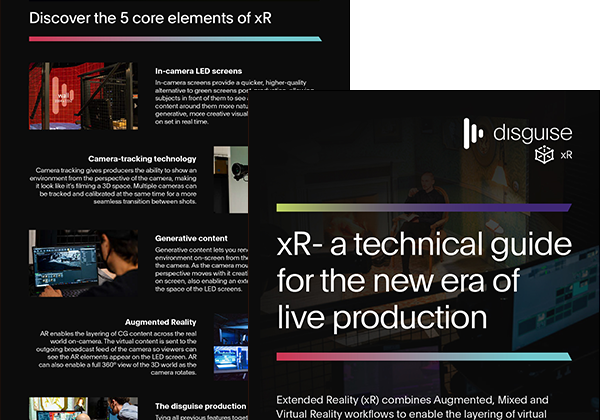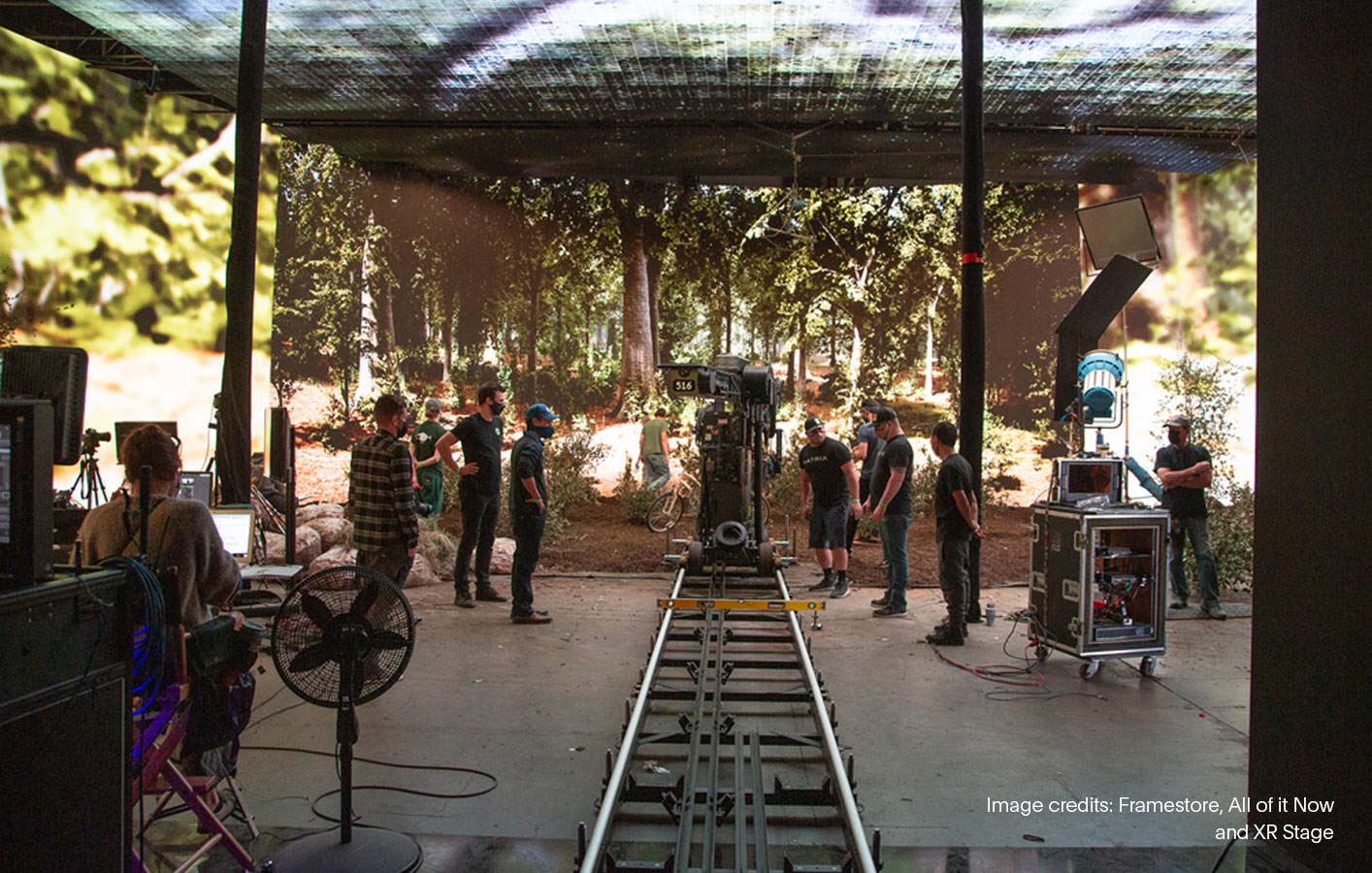
blog 2021 7 min read
How to get your production company to adopt virtual production

Is your studio yet to embrace virtual production? We've collated the benefits decisions makers will be interested in so you and your team can start creating.
At a glance, virtual production may appear to be toybox tech reserved for the Spielbergs, Favreaus and Camerons of the world. But that couldn’t be farther from the truth: virtual production is a seismic creative revolution on par with the advent of CG in the 90s, and it’s here to stay.
We’ve entered a new age in which the virtual and real worlds have melded into a real-time creative sandbox, and it’s already changing the way we approach episodic TV and feature film production.
Naturally, as with any emerging technology, there are question marks: studios considering virtual production in any form may need to consider hardware/software investment, risks associated with abandoning tried-and-tested pipelines, and potential organisation-wide retraining. How are upfront risks negated? Does the hype ring true? How soon can virtual production deliver ROI?
Virtual production is a wild new frontier—and in many ways one we’ve scarcely started exploring—but there exists already a wealth of evidence demonstrating the technology does more than just look good in a behind-the-scenes featurette. Indeed, virtual production presents significant pipeline, productivity, and bottom-line benefits that might just change your studio forever.
Greater pipeline flexibility = greater efficiency
Traditional visual effects and animation production is an assembly line, and it’s reaching the limits of efficiency. The upstream-dependent nature of inline visual effects means iteration is challenging, teams are siloed, and detrimental, clichéd, thinking like “fix it in post” is the norm.
Virtual production presents a significantly more malleable approach. With real-time processes, pre and post-production blur as all steps overlap. Once separated by workflows, teams and individuals can interact and iterate at any point in the pipeline. For example, pre-vis artists can help block out every pixel of a VFX shot before anyone sets foot on set. Production designers can experiment with a digital stage’s colour palette during principal photography. Actors can work with VFX supervisors to see the creature or object with which they’re interacting.
With virtual production, “fix it in post” becomes “fix it in pre” or “fix it in production”—you’ll face fewer crippling expensive reshoots, you’ll free up time to finesse in post, and you’ll run a production freed from the bottlenecks caused by debilitatingly long rendering delays.
Remove uncertainty
Real-time iteration removes the disconnect imposed by traditional visual effects pipelines on the production experience. In a “post-heavy” production, on-set creative decisions around visual effects are, at best, educated guesswork. This can necessitate extremely expensive (or even impossible) iterative changes when it comes to post.
A real-time feedback loop creates a more definitive version of a scene earlier in a production schedule. A director of photography can see, on set, what colour their lighting must be to match some unseen green screen element, for example, or an editor can cut in action using in-progress pre-vis to ensure shot continuity. Teams equipped with this knowledge long before post can take bold risks in the confidence their ideas won’t impact on budget later down the line.
Facilitate collaboration
Traditional pipelines don’t offer the magic of on-set interaction, as teams don’t often meet, and collaborative ideation is complex. In virtual production, departments come together and work together more organically. An FX artist could work with an explosives engineer in techvis to ensure straightforward augmentation of on-set effects in post, or a modelling artist might collaborate with a cinematographer to build out and manipulate ideas in real-time. Cross-pollination of disciplines is rife, leading to new ideas and, frequently, more cost-effective problem-solving.
Create better stories
Storytellers gain more than control with virtual production: they reclaim instinct. Real-time tools like simulcam, LED volumes or pre-vis mean directors can inhabit a digital world in the moment and go with their gut when making decisions on what a scene or sequence needs to make it work (as opposed to staring at green screens with only an abstract idea of what they will display until post-production). Such intuitive creativity means stories better reflect a director’s narrative vision—and more cohesive stories mean landing more work when your next pitch rolls around.
Attract and maintain new business
Spending on original content is growing as Netflix, Disney, HBO, and others seek to outdo one another on production values and next-gen spectacle. The streaming giants need facilities to produce their shows, and they’ll most likely partner with those proposing the fewest bottlenecks around budgeting, schedule, and iterative development.
You need only look back at the birth of CG in the early 90s to see how quickly production houses jump on new technologies that deliver faster output and higher quality. The demand for virtual production services will only increase for this very reason.
Discover the benefits of virtual production for film and episodic TV
Exploit assets to their full effect
The traditionally linear path from pre-vis to final pixel continues to give more freedom to those walking it. Many studios opting for virtual production now create high-quality assets in pre (which decimate in real-time pre-vis to display at the desired framerate). These studios are essentially commencing post-production at the project outset. Time is regained for finessing and improving the assets in post, rather than building the assets from scratch. And there’s an ancillary benefit: these high-quality assets are ready from day one for promotional marketing imagery, video game assets or toys, without needing to rebuild for each activation or face irritating consistency issues.
Remove risk and increase welfare in the age of COVID
COVID-19 created a risk-averse atmosphere around production, so now may be an opportune time to safeguard your business against future lockdowns. Virtual production is particularly suited to workplace safety and social distancing. It reduces travel, and on-location shooting and many processes can continue remotely, such as pre-vis blocking or discussing digital set builds via virtual reality. All this can be done without sacrificing any collaborative creative spirit.
The bottom line: long-term reduced cost
Although virtual production will invite costs in some areas, it will also dramatically reduce overheads in others. Accelerated time to market, reduced feature creep, tighter shooting schedules—such long-term savings can massively outweigh the initial investment of setting up a virtual production pipeline, and there are many more still to be uncovered.
The future of creativity
Virtual production undeniably offers technical efficiencies, strategic positioning opportunities, and a wealth of cost-saving benefits—but it’s all of those things and more.
The creative world is in the midst of a paradigm shift. Some will see it for what it is; others will only recognise the change when the initial opportunities are already in the rearview. But the signs are already here: real-time powered virtual production is a whole new way of approaching work. We’re not just looking at cost-savings or efficiencies; we’re looking at an iceberg tip of creative possibility, new stories, and new experiences. Now is the time to stay ahead of the curve and the competition and start producing next-generation narratives.
As virtual production technology evolves and real-time rendering solutions become ever more accessible to smaller-scale productions, the argument against virtual production is withering away. Whether you’re a filmmaker hoping to use virtual production processes creatively, or a studio head looking to leverage the technology for business opportunities and lowered production costs, virtual production should be under consideration for your current business strategy. The potential virtual production unleashes will fundamentally change the way you create and produce for yourselves and your clients, right now and into the future.
Cluster rendering: discover how virtual production is evolving

